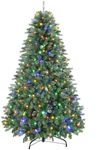Buying Guide for the Best Artificial Christmas Trees
Choosing the right artificial Christmas tree can make your holiday season more enjoyable and stress-free. Artificial trees come in a variety of styles, sizes, and materials, so it's important to consider your specific needs and preferences. Here are some key specifications to help you make an informed decision and find the perfect tree for your home.HeightThe height of an artificial Christmas tree is crucial because it needs to fit well in your space. Trees typically range from tabletop sizes (around 3 feet) to towering heights (up to 12 feet or more). To choose the right height, measure the ceiling height of the room where you plan to place the tree and subtract about a foot to allow for a tree topper. If you have low ceilings, a shorter tree will fit better, while high ceilings can accommodate taller trees.
WidthThe width, or diameter, of the tree at its widest point is important for ensuring it fits comfortably in your space without overwhelming it. Trees are often categorized as full, slim, or pencil. Full trees are the widest and provide a traditional look, slim trees are narrower and work well in tighter spaces, and pencil trees are very narrow and ideal for corners or small rooms. Consider the available floor space and choose a width that complements your room's layout.
Branch Tip CountThe branch tip count refers to the number of individual tips on the tree's branches. A higher tip count generally means a fuller, more realistic-looking tree. Trees with fewer tips may appear sparse and less natural. If you prefer a lush, dense appearance, look for trees with a higher tip count. However, if you like a more minimalist or modern look, a tree with fewer tips might be more suitable.
MaterialArtificial Christmas trees are typically made from PVC (polyvinyl chloride) or PE (polyethylene). PVC trees are more common and generally less expensive, but they may not look as realistic. PE trees are designed to mimic the appearance of real tree needles and often look more lifelike, but they tend to be pricier. Consider whether realism or budget is more important to you when choosing the material.
Pre-lit vs. UnlitPre-lit trees come with built-in lights, which can save time and effort during setup. They are available with various types of lights, such as clear, multicolored, or LED. Unlit trees allow you to customize the lighting to your preference but require additional time to string the lights yourself. If convenience is a priority, a pre-lit tree might be the best choice. If you enjoy decorating and want more control over the lighting, an unlit tree could be better.
AssemblyThe ease of assembly is an important factor to consider. Some trees come in multiple sections that need to be connected, while others have hinged branches that simply need to be unfolded. Look for trees with clear instructions and easy-to-follow assembly processes. If you prefer a hassle-free setup, choose a tree with fewer sections and hinged branches.
StorageConsider how easy it will be to store the tree when the holiday season is over. Some trees come with storage bags or boxes, while others may need to be disassembled and stored in their original packaging. Think about the storage space you have available and choose a tree that can be easily packed away and protected until the next year.

















